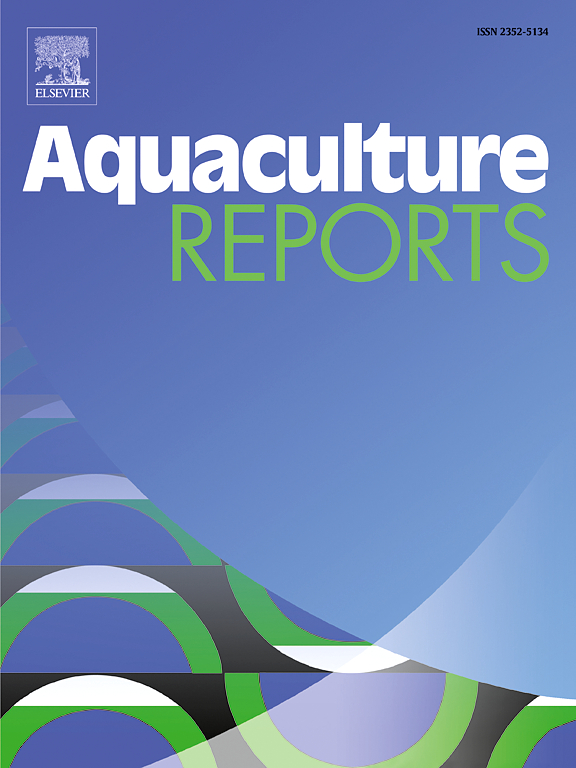A novel phage phaST4: Characterization and its protective potential against Aeromonas hydrophila infection in swamp eels
IF 3.2
2区 农林科学
Q1 FISHERIES
引用次数: 0
Abstract
The rise in antibiotic resistance of Aeromonas hydrophila has attracted increased concern and attention. In the present study, we isolated and characterized a novel phage designated phaST4 from aquaculture sewage. A morphological analysis revealed that phaST4 exhibited a symmetrical icosahedral head (85.5 ± 2.8 nm) and a long contractile tail (166 ± 3.3 nm × 22 ± 1.3 nm). Whole genome sequence analysis revealed that phaST4 is a double-stranded DNA phage of 90,646 bp in length. Its genome contains 113 putative open reading frames (ORFs) and 4 tRNAs. Moreover, no known virulence genes or drug-resistant genes were identified. Combined with a gene-sharing networks analysis, the results of sequence comparison and phylogenetic analysis indicated that phaST4 is the first representative of a new species within a previously undefined genus. The optimal multiplicity of infection (MOI) for phaST4 was 0.001, and the latent period and burst size were 20 min and 146 plaque-forming units (PFU)/infected cell, respectively. PhaST4 exhibited stable activity at 30°C–50°C and a pH range of 4–11. In addition, it showed a strong tolerance to chloroform. PhaST4 exhibited efficient biofilm inhibition and clearance capacity to its indicator host, as well as time- and MOI-dependent inhibition toward Aeromonas hydrophila in vitro. In addition, intraperitoneal injection of phaST4 significantly reduced the expression of inflammation-related genes, including NF-kB, IL-1β, and IL-6, in the liver and intestine of swamp eels challenged with A. hydrophila. A histopathological analysis revealed that phaST4 administration ameliorates liver and intestinal injury compared with the bacterial infection groups. Overall, the results indicate that phaST4 has potential use for the treatment of A. hydrophila infection.
一种新的噬菌体4:表征及其对沼泽鳗鱼嗜水气单胞菌感染的保护潜力
嗜水气单胞菌抗生素耐药性的上升引起了越来越多的关注和重视。在本研究中,我们从水产养殖污水中分离并鉴定了一种新的噬菌体,命名为phas4。形态分析显示,phaST4展出一个对称的二十面体的头(85.5 ±2.8 海里)和长收缩的尾巴(166 ±3.3 nm×22 ±1.3 海里)。全基因组序列分析显示,phasst4是一个长度为90,646 bp的双链DNA噬菌体。其基因组包含113个假定的开放阅读框(orf)和4个trna。此外,没有发现已知的毒力基因或耐药基因。结合基因共享网络分析,序列比较和系统发育分析结果表明,phasst4是一个未定义属中新物种的第一个代表。第4阶段的最佳感染倍数(MOI)为0.001,潜伏期和爆发大小分别为20 min和146菌斑形成单位(PFU)/感染细胞。phas4在30°C - 50°C和4-11 pH范围内表现出稳定的活性。此外,它对氯仿有很强的耐受性。PhaST4对其指示宿主表现出有效的生物膜抑制和清除能力,并在体外对嗜水气单胞菌具有时间和moi依赖性的抑制作用。此外,腹腔注射phasst4显著降低了嗜水单胞杆菌攻毒泥鳅肝脏和肠道中NF-kB、IL-1β和IL-6等炎症相关基因的表达。组织病理学分析显示,与细菌感染组相比,第4期给药可改善肝脏和肠道损伤。总的来说,结果表明,phasst4在治疗嗜水单胞菌感染方面具有潜在的用途。
本文章由计算机程序翻译,如有差异,请以英文原文为准。
求助全文
约1分钟内获得全文
求助全文
来源期刊

Aquaculture Reports
Agricultural and Biological Sciences-Animal Science and Zoology
CiteScore
5.90
自引率
8.10%
发文量
469
审稿时长
77 days
期刊介绍:
Aquaculture Reports will publish original research papers and reviews documenting outstanding science with a regional context and focus, answering the need for high quality information on novel species, systems and regions in emerging areas of aquaculture research and development, such as integrated multi-trophic aquaculture, urban aquaculture, ornamental, unfed aquaculture, offshore aquaculture and others. Papers having industry research as priority and encompassing product development research or current industry practice are encouraged.
 求助内容:
求助内容: 应助结果提醒方式:
应助结果提醒方式:


